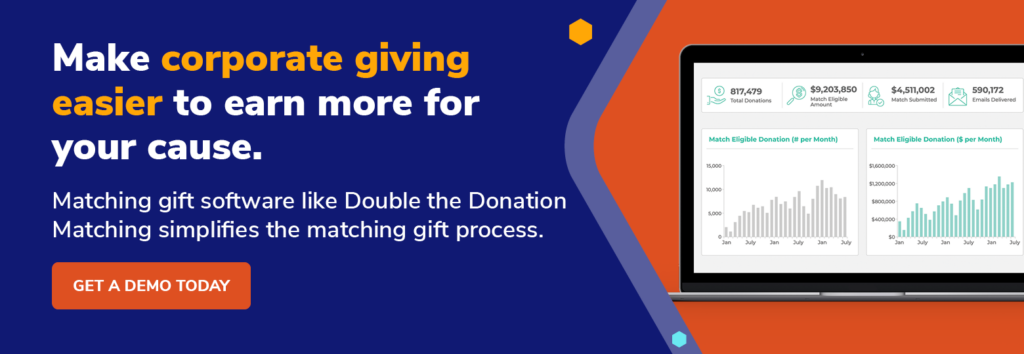What Is Corporate Giving? The Ultimate Guide to Earning More
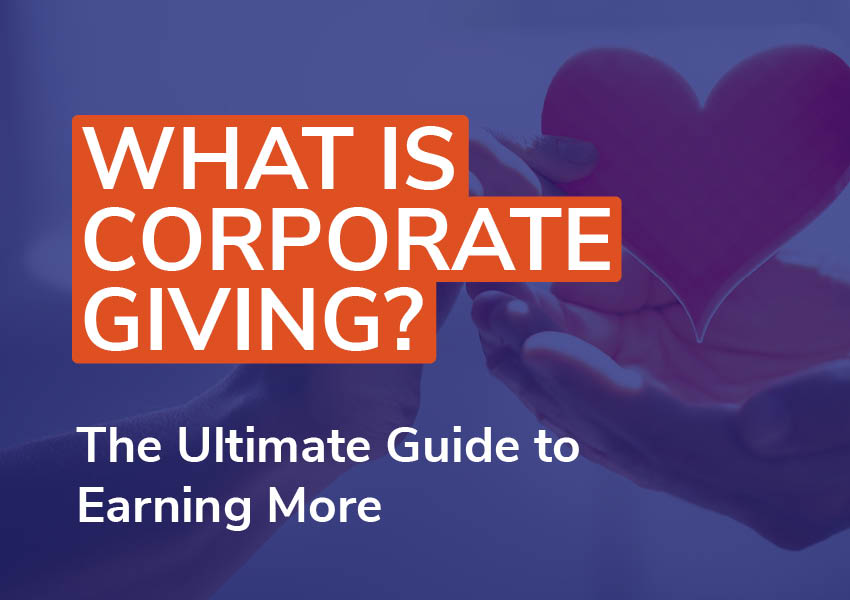
If you’re a nonprofit professional, you’re likely familiar with the hustle of securing funding for your cause. From brainstorming new fundraising ideas to reaching out to prospective donors, nonprofits use much of their team members’ time to figure out how to raise more money.
But what if there was an easier, less energy-intensive way to earn more for your nonprofit’s cause? Corporate giving allows nonprofits to maximize community support by leveraging nonprofit-oriented programs that companies have already established. As a result, these organizations can gain new connections with like-minded businesses and expand their networks.
In this guide, we’ll answer the following questions related to corporate giving:
- What Is Corporate Giving?
- What Are the Benefits of Corporate Giving?
- What Are the Different Types of Corporate Giving?
- How Can Companies Start Corporate Giving Programs?
- Which Companies Offer Corporate Giving Programs?
- How Can Nonprofits Leverage Corporate Giving Software?
- How Can Companies Leverage Corporate Giving Software?
Whether you’re a nonprofit trying to raise funds or a business looking to expand its corporate philanthropy programs, we’ll walk you through everything you need to know about corporate giving. Let’s get started by defining what exactly corporate giving is.
What Is Corporate Giving?
Corporate giving occurs when companies financially contribute to nonprofit causes. These types of programs often incentivize employee giving with company donations. Corporate giving programs fall under the wider umbrella of corporate philanthropy, which refers to any support companies provide to nonprofits.
One of the best aspects of corporate giving is that companies of any size can participate. From locally owned neighborhood shops to the largest corporations, all companies can easily establish corporate giving programs and give back to the causes they care about.
What Are the Benefits of Corporate Giving?
The largest benefit of corporate giving for nonprofits is without a doubt the funding companies provide. In fact, the top 10 philanthropic corporations alone donate over $2 billion to nonprofits each year as part of their corporate giving programs, and in total, companies gave over $21 billion to nonprofits in 2022. That amount of funding has the potential to completely skyrocket the amount of support nonprofits can provide their beneficiaries.
However, there are even more benefits of corporate giving for nonprofits, including: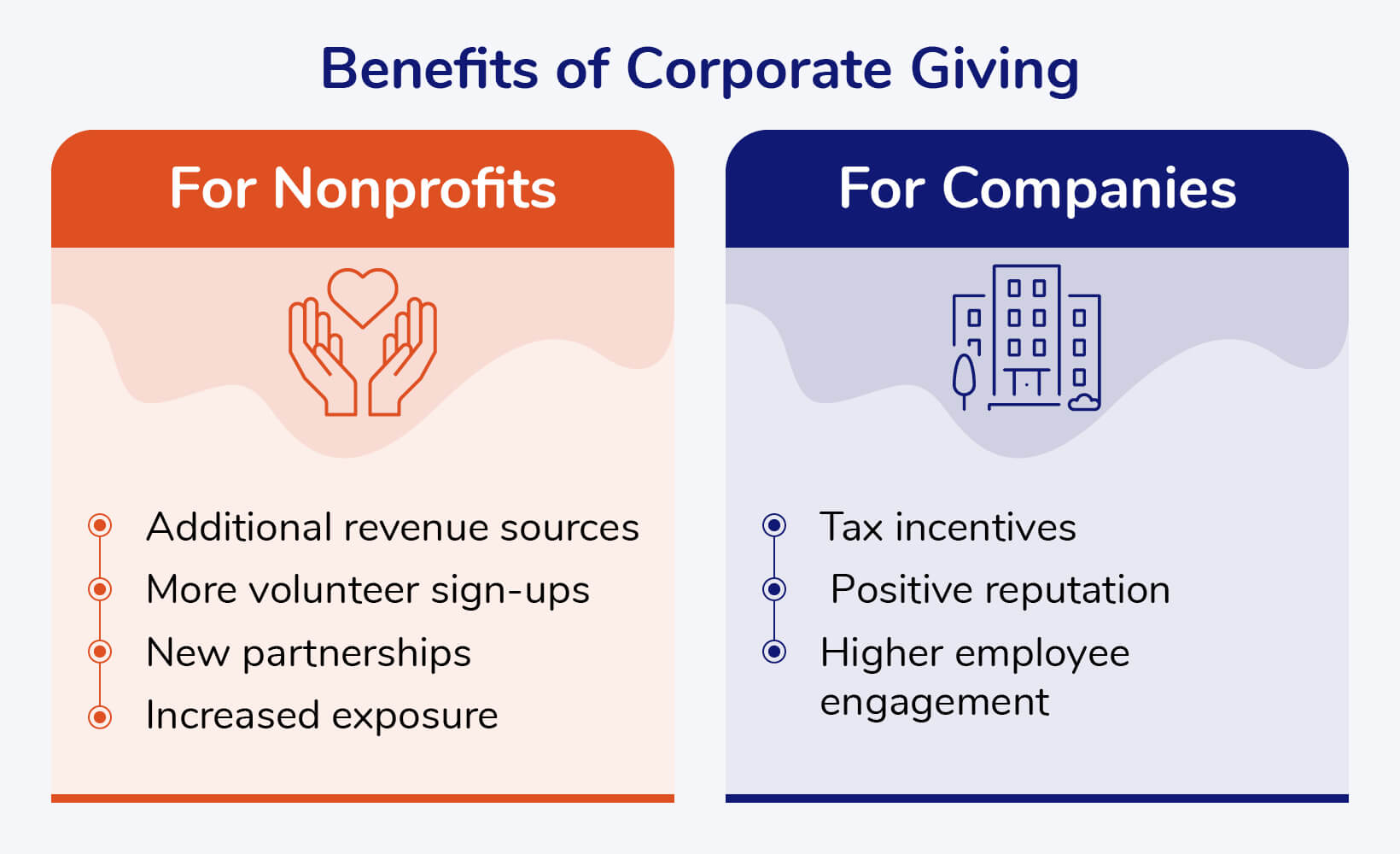
- Additional revenue sources. Not only does corporate giving allow nonprofits to earn more for their causes, but it also helps them diversify their revenue sources. When nonprofits know they’ll receive significant support from businesses, they can rely less heavily on individual donations and be more confident that they’ll have enough funds to support their operations going forward.
- More volunteer sign-ups. Certain corporate giving programs like volunteer grants encourage employees to volunteer with nonprofits. As a result, nonprofits not only earn money from the volunteer grants but also gain a new base of dedicated volunteers.
- New partnerships. The connections nonprofits form with businesses through corporate giving programs can open up opportunities for further partnership in the future. For example, if a business notices that many of its employees donate to the same cause, it can reach out to that organization and offer to sponsor their next fundraising event.
- Increased exposure. When large corporations partner with specific nonprofits, they usually advertise these relationships, both to their own staff and their customers. Nonprofits can gain even more support from this promotion.
While the advantages of corporate giving might be more evident on the nonprofit side, participating companies also receive many benefits, such as:
- Tax incentives. Since the majority of donations companies make to nonprofits are tax-deductible, they can actually save money in the long run by leveraging corporate giving.
- Positive reputation. Companies that contribute to nonprofits stand out from competing businesses, both in the eyes of customers and prospective employees. When companies participate in corporate giving, they show that they’re committed to making the world a better place and upholding their company values.
- Higher employee engagement. Did you know that actively disengaged employees cost the organizations they work for $483-$605 billion per year? Corporate giving programs are a great way to engage employees because they allow employees to maximize support for the causes they care about. Plus, 71% of employees say it’s important to them to work at a company that contributes to nonprofits, demonstrating that corporate giving programs can help businesses retain their employees.
Ultimately, corporate giving programs are valuable for both nonprofits and businesses because they allow them to enter meaningful partnerships that support those in need.
What Are the Different Types of Corporate Giving?
There are so many forms of corporate giving that businesses could choose to participate in. Companies can mix and match different methods to create the perfect corporate giving program for their organizations.
Let’s review some of the most popular ways that businesses give back to nonprofits.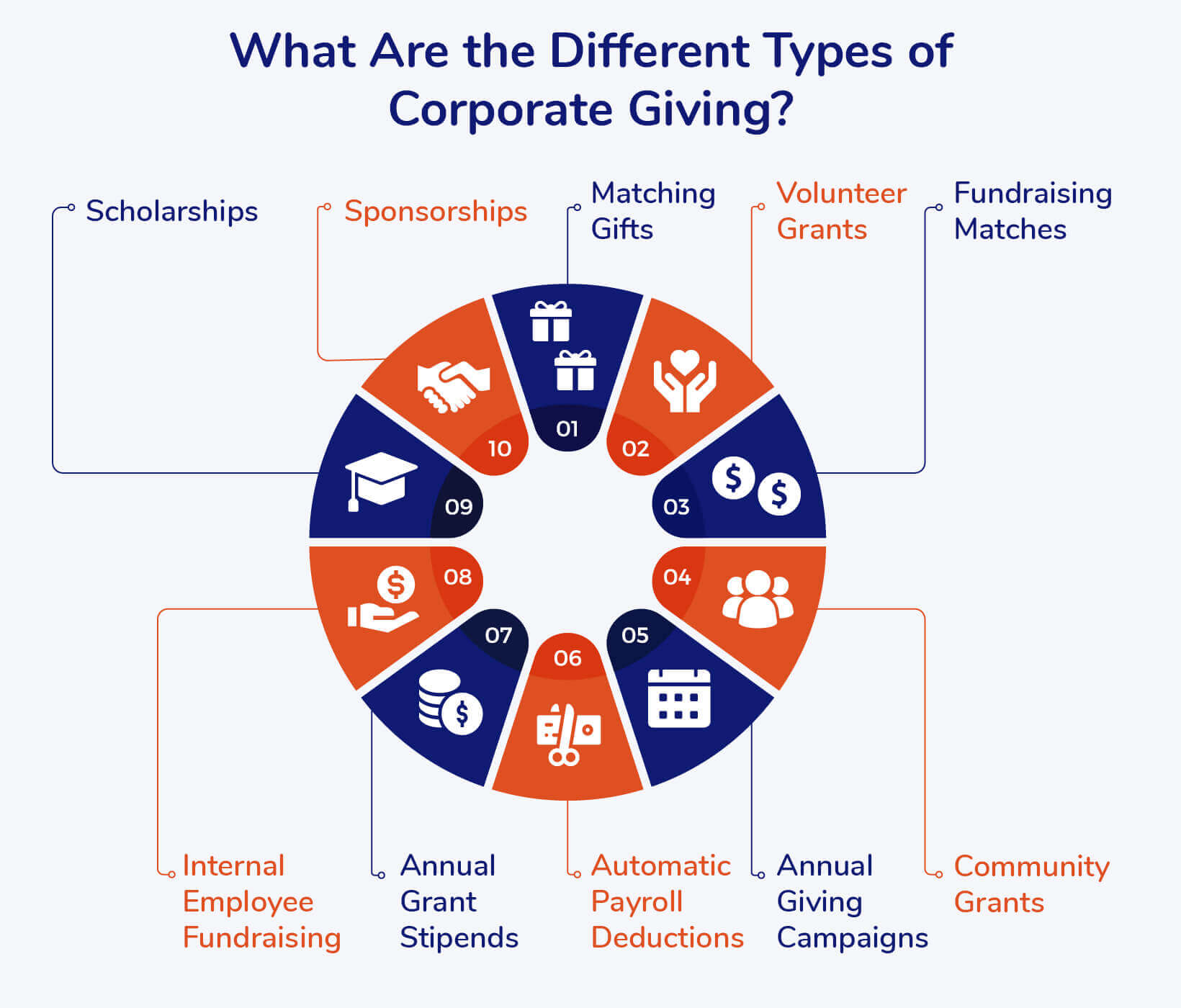
Matching Gifts
By far, the most popular form of corporate giving is matching gifts, with 65% of Fortune 500 companies offering matching gift programs. The concept of a matching gift is simple: An employee contributes to their nonprofit of choice, and their employer matches their donation at a predetermined ratio.
As a result, nonprofits can double or even triple the individual donations they already receive. Corporate giving research even indicates that 1 in 3 donors will actually increase their donations if their employer will match their gifts, making it a great way to motivate donors.
While it’s easy for nonprofits to receive matching gifts, there is a matching gift process that must be followed from start to finish in order for employers to match their employees’ donations. The process involves the following steps:
- A donor contributes to their nonprofit of choice.
- That donor checks to see if their donation is eligible for matching, either by doing their own research or using a matching gift database.
- If the donor determines their gift is match eligible, they submit a matching gift request form to their employer.
- The donor’s employer reviews the request and checks with the nonprofit that the donation was made.
- The employer matches the employee’s donation.
As you can see, matching gifts require very little effort on the part of nonprofits and have the potential to dramatically increase their funding. However, 78% of donors are unaware if their company offers a matching gift program, so it’s crucial for nonprofits to promote these opportunities to their supporters.
Volunteer Grants
Another common corporate giving initiative is volunteer grants, with 40% of Fortune 500 companies offering volunteer grant programs for their employees.
Volunteer grants function very similarly to matching gifts. Instead of matching employee donations, companies donate to nonprofits based on how many hours their employees volunteer with them. Some companies opt to contribute a set grant amount once employees have volunteered for a certain number of hours instead.
The volunteer grant process functions very similarly to the matching gift process:
- A volunteer works with their nonprofit of choice.
- That volunteer checks to see if their volunteer time is eligible for a volunteer grant, either by doing their own research or by using a volunteer grant database.
- If the volunteer determines that they’re eligible for a volunteer grant, they submit a volunteer grant request to their employer.
- The volunteer’s employer reviews the request and checks with the nonprofit that the volunteer did in fact work with that nonprofit.
- The employer contributes to the nonprofit.
Considering about 63 million Americans volunteer each year, volunteer grants can not only help nonprofits earn more for their causes but also dramatically increase the value of their volunteers’ work.
Fundraising Matches
In addition to donations and volunteer time, some companies will contribute to nonprofits based on their employees’ fundraising efforts. For example, let’s say you’re preparing to participate in an upcoming walk-a-thon. You collect pledges from family and friends based on the number of miles you walk. After the walk-a-thon is over, you gather all the pledged donations and contribute them to your cause of choice.
If your employer participates in fundraising matches, you can submit a fundraising match request and have your employer double the amount you give back to the nonprofit you’re supporting. Some companies set up this type of program as a run/walk/ride sponsorship instead, in which they’ll donate a set amount to an employee’s peer-to-peer campaign for a walk-a-thon, bike-a-thon, or 5K race.
Community Grants
Some companies offer community grants to help out local nonprofits in need. For example, a company based in an area that just experienced forest fires may create a disaster relief grant to assist nonprofits working with victims of the fires.
The difference between this type of grant and other forms of corporate giving is that nonprofits must pursue community grants themselves. Instead of relying on donors and volunteers to reach out to their employers, nonprofits must apply for community grants, sometimes filling out extensive paperwork to receive the funding.
Annual Giving Campaigns
Just as nonprofits promote annual giving, so do companies. Businesses will encourage their employees to give back during specific times of the year, such as dedicated giving days like GivingTuesday. Nonprofits can seek out these opportunities by checking company websites and social media profiles.
While companies can conduct annual giving campaigns during any time of year, the most popular time for them to promote annual giving is at the end of the year during the holiday season. They may encourage their employees to lean into the giving spirit and contribute to their nonprofits of choice or an organization the business partners with. It’s also beneficial to run annual giving campaigns at the end of the year because employees have a better idea of how much they can give at that time.
Automatic Payroll Deductions
Many companies allow employees to automatically contribute a portion of their paychecks to nonprofits, helping them to leverage the popular CSR trend of workplace giving. That way, it’s easy for employees to continuously give back to their favorite causes without any further action needed on their part.
A company might limit which types of nonprofits its employees can contribute to in automatic payroll deductions based on the company’s values. They may prefer for their employees to only give to education-based organizations or environment-oriented nonprofits, depending on the type of work that resonates with the company.
As a result, businesses may compile lists of approved nonprofits that their employees can choose from for their automatic payroll deductions. Once a nonprofit is on a company’s list, it’s easy for them to regularly receive funds from that company’s employees.
Annual Grant Stipends
Annual grant stipends are like volunteer grants, except no volunteer hours are required. Companies simply give a predetermined amount of money to their employees each year that they can donate to their favorite nonprofits.
While annual grant stipends are not as common as other forms of corporate giving, they’re an incredibly easy way for employees at participating companies to give back to the causes they care about.
Internal Employee Fundraising
Workplace giving campaigns allow your business to leverage its own team to contribute to nonprofit causes, boosting employee engagement in your corporate philanthropy efforts. Here are a few popular examples of internal employee fundraising campaigns your company can try:
- Team fundraising challenges where different groups of staff members compete against each other to raise the most money through a peer-to-peer campaign.
- Lunch and learn sessions in which a board member or leader at a local nonprofit speaks to your employees about their organization and provides an opportunity to give.
- In-kind donation drives to allow your employees to give physical items rather than just monetary donations.
- Company-wide volunteer days or paid volunteer time off so staff members can also give their time to nonprofits.
Because your staff members are already dedicated to your values, asking them to contribute to a nonprofit whose mission aligns with those values can help you earn more for a good cause. Plus, you know your team the best, so you can tailor your employee giving initiatives to their interests and needs.
Scholarships
For schools and education-based nonprofits, scholarships are the ultimate form of corporate giving. Some companies will aid students by paying for their tuition, books, living expenses, food, and other associated costs. Most of the time, students must seek out and apply for these scholarships on their own.
Your nonprofit may not directly benefit from scholarships, but they can help your beneficiaries fund their education. Therefore, you can compile a list of relevant scholarships for your beneficiaries so they can easily apply for and receive funding.
Sponsorships
If your nonprofit is looking for funding for a specific event, activity, or project, seek out a corporate sponsorship. Sponsorships are extremely helpful when your budget is too tight to host your certain initiatives.
To obtain a sponsorship, nonprofits typically contact companies or fill out an application for a specific amount of funds. For example, a nonprofit may be looking for a business to sponsor its upcoming auction in the amount of $15,000. To thank sponsors for their contributions, nonprofits typically feature sponsors in promotional materials and give them a shoutout on social media.
Sponsorships are not only a great way to gain funding for specific initiatives but also to launch lasting partnerships between nonprofits and like-minded businesses.
How Can Companies Start Corporate Giving Programs?
If you’re a company looking to start your own corporate giving program, you’ve come to the right place! Follow these steps to set your program up for success: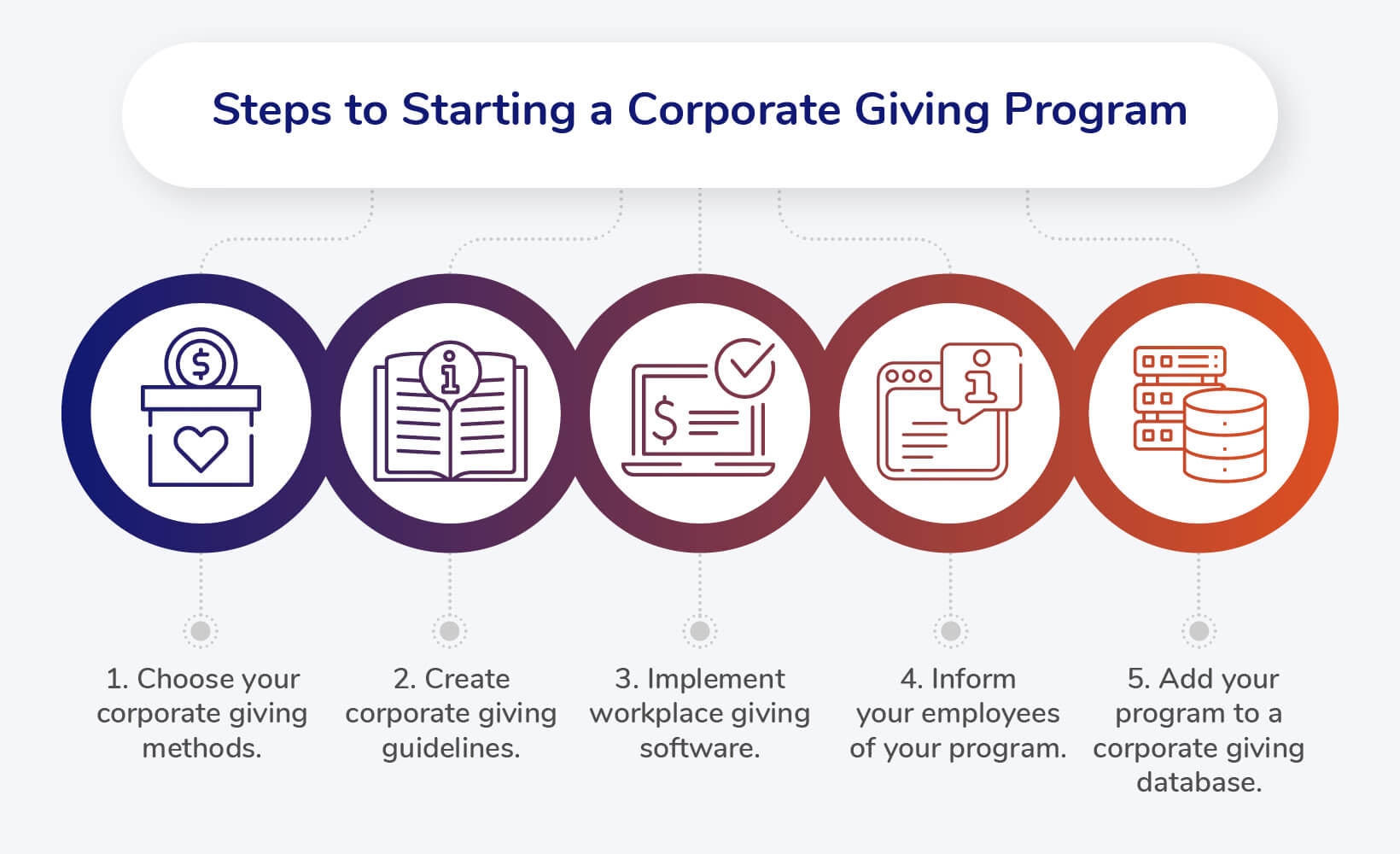
- Choose the types of corporate giving you’d like to pursue. Mix and match the corporate giving ideas that resonate most with your company and your employees. For example, if your employees volunteer often, you may want to offer volunteer grants and automatic payroll deductions that allow them to contribute to the causes they care about.
- Create corporate giving guidelines. Decide how you’ll determine corporate giving eligibility. You may restrict your corporate giving program to only full-time employees or only nonprofits in certain verticals. For programs that offer donation matches, establish minimum and maximum corporate donation amounts. Similarly, you’ll want to create a minimum and maximum number of volunteer hours required if you choose to offer volunteer grants. Lastly, determine your matching ratio and submission deadlines for any donation match requests.
- Implement workplace giving software. This type of software allows you to easily manage your corporate giving program, from accepting corporate giving requests from your employees to tracking how much your company has contributed to charitable causes year to year.
- Spread the word about your program. Once you establish your corporate giving program, make sure your employees know about it! Hold a company-wide meeting that explains the purpose of the program, the corporate giving initiatives it features, and how employees can participate.
- Add your program to a corporate giving database. To make it easier for your employees to participate in your program, add your company to a corporate giving database. For example, Double the Donation’s database features information about company matching gift and volunteer grant programs. Nonprofits embed these databases into their websites so donors and volunteers can easily check their eligibility before contributing to charitable causes. As a result, your employees can facilitate the matching gift or volunteer grant process right from nonprofit websites without having to do extensive research on your corporate giving program.
While the steps involved in starting your corporate giving program are simple, don’t worry if it takes some time to set everything up. Your goal should be to create a lasting, impactful program, so take all the time you need to make a program that works well for your team.
Which Companies Offer Corporate Giving Programs?
According to a Forbes survey of 250 multi-billion-dollar companies, 92% of these companies offer some sort of matching program to their employees. This statistic illustrates just how many companies out there are committed to funding nonprofits and contributing to social good.
With so many companies to choose from, how does your nonprofit find the right corporate partners to work with? Or, if you’re a business, which companies should you look to for inspiration? We’ll review three of the top companies with corporate giving programs, taking a look at how these CSR examples organize their programming and rally their employees.
Disney
Disney is committed to helping children and families around the world. In 2022, they gave about $233 million to deserving nonprofits. They mostly support children’s hospitals, arts and STEM education, and environment conservation. Disney also has a generous matching gift policy, matching employee donations up to $25,000 at a 1:1 ratio.
Additionally, Disney offers a volunteer program called Disney VoluntEARS. Through this program, volunteers can earn up to $2,000 for the nonprofits they volunteer with. For volunteers who go above and beyond, Disney recognizes these individuals as “VoluntEARS of the Year” and grants $2,500 to their associated nonprofits.
Nonprofit partnerships are also a significant element of Disney’s corporate giving program. For example, Disney has donated over 90 million books to First Book, gives toys each holiday season to Toys for Tots, and sponsors the Special Olympics.
Disney’s program represents a range of corporate giving options that work together to support children in need.
Starbucks
From veterans to college students to farming communities, Starbucks helps a variety of charitable causes. For example, through its Starbucks Foundation Origin Grants, Starbucks supports women in coffee and tea-origin communities across Africa, Asia, and Latin America. The grants serve to promote women’s leadership, provide economic opportunities, and expand access to clean water.
Starbucks also contributes to nonprofits dedicated to workplace diversity, sustainability, and disaster relief through the Starbucks Foundation.
Through Starbucks’ Giving Match Program, Starbucks provides volunteer grants of $5 per volunteer hour for employees who have volunteered at least 25 hours with a nonprofit. They also offer matching gifts of up to $1,000.
What stands out about Starbucks’ corporate giving program is that it gives back to causes that specifically relate to its work and values. Starbucks’ commitment to supporting coffee and tea-origin communities in particular shows that they not only serve coffee but also care about the people who put hard work into making each cup of coffee possible.
The Home Depot
Through The Home Depot Foundation, The Home Depot focuses on three main charitable initiatives: serving veterans, filling the labor gap, and providing disaster relief. In particular, the company has invested over $475 million since 2011 and has renovated over 55,000 veteran homes and facilities.
As part of their Path to Pro program, The Home Depot has pledged to invest $50 million to train skilled tradespeople. They’ve already trained more than 41,000 participants. Path to Pro also features a scholarship element, awarding scholarships to students pursuing trade colleges or postsecondary programs.
Two of The Home Depot’s main partnerships are with the Home Builders Institute and Atlanta Technical College. With the Home Builders Institute, The Home Depot has provided almost 1,200 people exiting military service with pre-apprenticeship certification so they can easily find jobs after their service. The Home Depot also collaborated with Atlanta Technical College to create the Center for Workforce Innovation, which helps students develop professional skills and obtain work-based apprenticeships and internships.
Like other companies, The Home Depot also offers volunteer grants and matching gifts to round out its corporate giving program.
How Can Nonprofits Leverage Corporate Giving Software?
Corporate giving opportunities like matching gifts are great ways for nonprofits to earn more for their causes. However, if donors don’t know about these opportunities, they miss out on chances to give back to their favorite nonprofits.
It’s estimated that $4-$7 billion in matching gift funds goes unclaimed annually. Think about how much more nonprofits could do with that extra funding!
To ensure eligible donors know about relevant corporate giving initiatives, nonprofits can promote these programs using corporate giving software.
Double the Donation Matching is the ideal choice for corporate giving software because it contains information on tons of company matching gift and volunteer grant programs. Donors and volunteers can easily check their grant eligibility and submit the appropriate forms to their employers. Plus, over 8,500 nonprofits already use the software and have seen their donation revenue soar.
Check out how Double the Donation Matching streamlines the matching gift process with the following steps:
- After a donor contributes to your organization, Double the Donation Matching determines their matching eligibility by scanning their email or employer information.
- If the donor is eligible, the platform will automatically send them an email prompting them to submit a matching gift request.
- Double the Donation Matching will store information about the status of each matching gift request so you can watch the matching gift revenue trickle in.
When you use this type of corporate giving software, you can ensure your organization receives more donation revenue without having to devote extra team member time to matching gift outreach. Once you have the platform set up, you can leave it up to the software to automate the matching gift process, resulting in even more funds for your cause.
Plus, Double the Donation Matching now offers auto-submission functionality that submits matching gift request forms on the donors’ behalf. That way, you can expedite the matching gift process even further, ensuring that matching gift requests get sent and result in increased funding for nonprofits.
How Can Companies Leverage Corporate Giving Software?
If companies want to help nonprofits as much as they possibly can, they’ll leverage software to facilitate the corporate giving process. Especially if your company offers multiple different forms of corporate giving, it can be difficult to keep up with the demands of each one unless you have a dedicated solution. Plus, using corporate giving software makes it easier for employees to participate, leading to higher program engagement.
Take a look at all of the corporate giving program elements that software can help you organize:
- Employee donations
- Automatic payroll deductions
- Matching gift requests
- Volunteer hour logs
- Volunteer grant requests
- Team volunteer opportunities
- Company corporate giving statistics
When you can keep track of all of your corporate giving metrics and information in one place, you make it easier for your employees to get involved. Employees can simply submit all of their relevant information to this corporate giving hub, and as a result, your company can easily act on donation requests and give back to deserving nonprofits.
Wrapping Up: Additional Corporate Giving Resources
Nonprofits and companies alike benefit from strong corporate giving programs. While nonprofits get more funds and support for their causes, companies create opportunities for employee engagement and get to demonstrate the social good they do. Partnerships between nonprofits and companies can last many years and ultimately help make the world a better place.
If you want to learn more about corporate giving, check out the following resources:
- Matching Gift Software Vendors: The Comprehensive List. Is your nonprofit interested in leveraging corporate giving software? Check out the top matching gift software options.
- How to Develop a Matching Gift Program: A Step-by-Step Guide. Companies looking to develop matching gift programs may have some questions about how to get started. This guide will walk you through the process step by step.
- How to Advocate for a Matching Gift Program to Your Employer. Want to help your favorite nonprofits earn more for their causes? Learn how you can advocate for a matching gift program to your employer with the help of this article.
